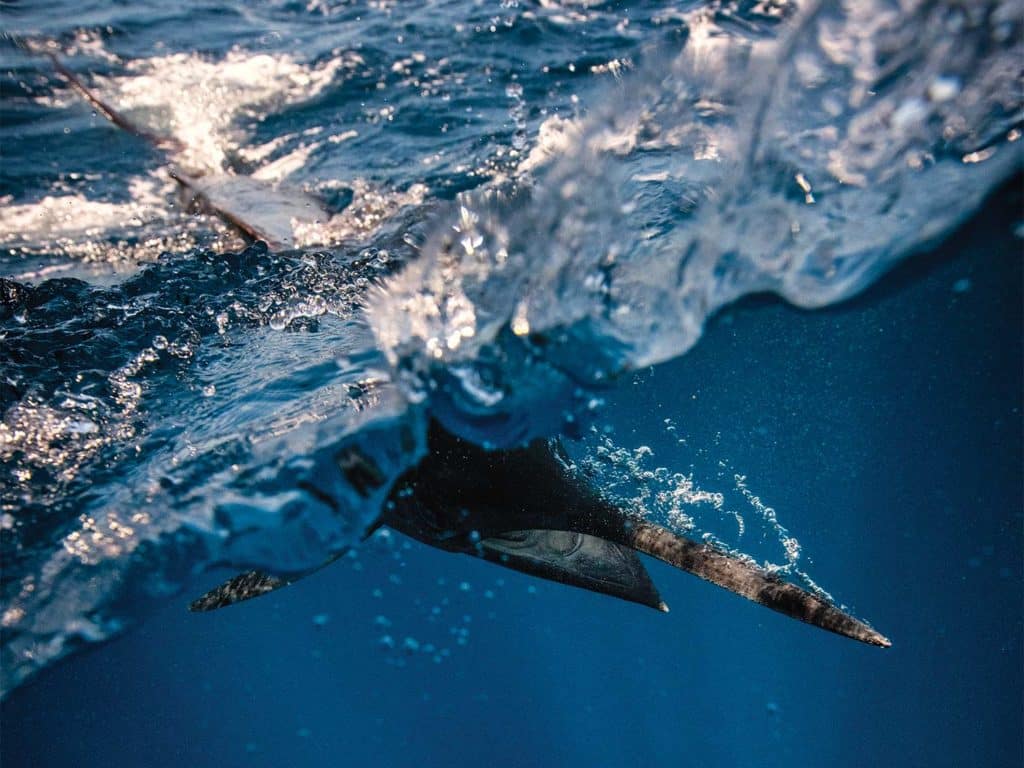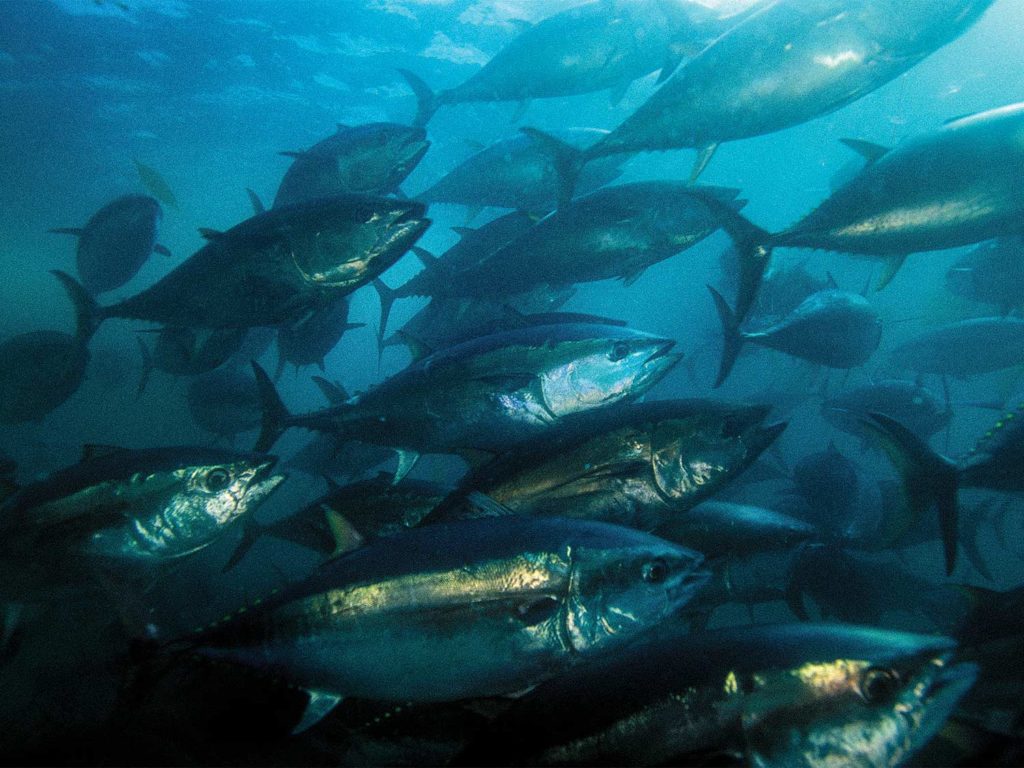
What exactly can marlin “hear”? As I started to dive into this topic, I immediately hit a roadblock. No one has been able to keep a billfish alive in captivity, so unfortunately, unlike some other penned species such as tuna, no studies have been conducted on what and how marlin hear.
This inquiry brings on another question: What do billfish hear down there, and how are sounds perceived? Ironically, this is the same question I began asking as I was putting together a piece on raising fish, and what we can do to turn our own vessels into fishy boats.
Have you ever run over a mark on your screen that looked like a nice marlin sulking in the depths and wondered what it is that actually brings it up to investigate your pattern? Presumably, if the mark is deeper than 20 fathoms, we can assume that the fish is deep enough where sight alone would make little or no difference in raising them to the surface. So it must be sound that sparks their interest, right? Well, maybe.
Watch: Marlin in the dredge!
My first order of business was to speak with marine scientists and experts in the field, and read as much on the study of fish hearing as I could find. The research led to some interesting discoveries that better illuminated a picture of what these animals might be hearing deep down in the dark water column. It also brought to question what techniques we might tweak in our trolling efforts for marlin.

First, Some Science
The scientists proved helpful in getting me started on my path to understanding how fish hear and perceive sound. I first consulted with Professor Emeritus Dr. Arthur N. Popper from the University of Maryland, who has studied fish hearing for over 50 years and published hundreds of papers on the subject. After that, Dr. Richard Brill from the Virginia Institute of Marine Sciences, who sent me several pieces of literature that proved extremely interesting. It seemed that everyone in the field who I spoke to had similar—and somewhat conflicting—conclusions on what billfish might be hearing in their hunt for food and survival.
To understand these studies, it was important that I put aside my own ideas of how humans hear on dry land; how we hear and detect sound. And because our target lives in a very different element than our own, and sound travels at a different speed through water than through air due to the density of the medium, we must understand what fish use to detect sound.
For years, I thought it was through the lateral-line system that pelagics detect sound, but as I began my research, I quickly discovered that this is not necessarily correct. A fish’s lateral line serves to detect water movement, such as that produced by nearby fishes and low-frequency sounds, but only when the sources are very close to the animal.

As it relates to marlin fishing, the lateral line is used to detect water movement coming off other fish (think lure action). The lateral line is, therefore, likely to be used when approaching prey closely, just before the attack, and this is why I personally have always said that action trumps color.
So, picture this: A marlin has “heard” the sound of your vessel engaged in fishing. As it comes closer to investigate the commotion and the shadow the boat creates, it starts its probe using sight, looking at the spread—its perceived prey. As the fish gets closer, stalking and lining up each bait, it will then begin to use its short-range lateral line to help position itself and make possible presumptions on both the position and movement of the prey, which then, hopefully, activates its kill drive.
Deciphering Billfish Hearing
What is it then that enables large pelagics to locate prey? For this, I leaned heavily on Popper to put it in language everyone could understand: “It is likely that sound plays a role since it is generally important to fishes, just as it is to humans. Like humans who learn a great deal about things around them, and particularly when the things are out of sight, from sound—imagine sounds of fire engines when you are driving, a baby crying in another room—fish also use sound to learn about predators and prey, as well as the environment.”

So how does a marlin hear? Popper continues: “Fish obviously have no external ear, but they do have an inner ear that is similar to our own in many ways. This inner ear lies in the brain cavity, behind the eyes. The hearing part of these ears in marlin and many other species contains very hard and dense structures called otoliths, which lie right next to the cells in the ear that translate sound in water to signals that go to the brain and are perceived by the animal as sound.
“Because most of the fish’s body is about the same density as water, sounds would normally pass through the fish without being detected. However, fish have special ways to detect sounds. One way is using the otoliths. When the sound hits the fish, the body moves with the sound field. However, the otoliths, being much denser, do not move, and they rub against the sensory structures in the ear.
“Many fish, such as marlin, have a second way of potentially getting sound to the ear. This is because the swim bladder is filled with air. The air is not dense, and so when a sound comes along, the swim bladder starts to vibrate just like the walls of an air-filled balloon do when you make excessively loud sounds nearby.

“These vibrations produce a very quiet sound from the swim bladder that may go to the inner ear and stimulate the otoliths just like the sounds that directly go to the ear. However, this sound decreases as it goes from the swim bladder, and participates in hearing only if the swim bladder and ear are near one another. Otherwise, the swim bladder sound is too low to be detectable.”
Of course, one wonders why there are these two paths of sound to the ear? Much research performed in labs around the world have shown that in species where the swim bladder does not contribute to hearing, the fish can hear up to about 500 Hz, whereas species that have a swim bladder near the ear can hear up to about 4,000 Hz.”
While this information might be helpful to fishermen, it doesn’t really explain how a fish in the 40-fathom range can become aware of a vessel and baits running overhead. Fish aren’t really attracted to—or even spooked by—the sounds produced by splashing lures or water sprayed off the hull because they might be used to those sounds.
Fish-Hearing Experiments
What we do know in terms of sounds that might spark a pelagic’s interest comes from studies done by scientists on captive bluefin tuna. In these studies, Popper and his colleagues trained the tuna to go to a feeding site near the center of a large tank whenever they heard a particular sound. The fish were first trained to go to a light at the feeding site, and over time, the researchers dimmed the light and raised the sound level. Eventually, the tuna would swim around the edges of the tank until they heard a sound, and then go to the center to be rewarded with food. If the fish did not hear the sound, they would not go to the feeder. By playing different sounds, the scientists could figure out which sounds the tuna could hear and which they could not, similar to a human-hearing test where audiologists ask the person to raise their hand when they hear a sound. If no sound is heard, the hand is not raised.

As a result, the fish were able to “tell” the researchers which sounds they could hear and which they could not. Subsequently, it was discovered that bluefin can detect sounds from below 200 Hz to about 800 Hz, or 200 to 800 cycles per second. However, the tuna did not respond to frequencies above that range, indicating they could not hear them.
The researchers also found that bluefin tuna were most sensitive to sounds at 500 Hz, which is around the same frequency that anchovies and squids produce when schooling, according to a 1960s study by Dr. James M. Moutlon. This is also the same range of frequencies that Dr. Robert Iversen showed in Hawaii in the 1960s that other tuna species can hear.
GF Timofeev found in 1965 that skipjack tuna produce “knocks” in the 500 to 700 Hz sweet spot that appear to cue their schools to sound or relocate. This data also suggests tunas hear in the 200 to 800 Hz range, and are most sensitive to sounds in the 500 Hz zone. In contrast, humans are able to distinguish sounds from 20 Hz to about 20,000 Hz, but we decline at the higher frequencies as we age.
Sound Intensity
Iversen’s research found that loud and sudden sounds in the 500 Hz range would cause the tuna to dart away from the source. However, a steady signal would not result in a similar response. Iversen did, however, learn that sudden, loud 500 Hz sounds would push the tuna away from the source, and they were able to steer the tuna toward certain areas of the tank using this method. These results fit in with the findings that other fish and sharks are most interested in sounds that are of short duration and, in some ways, resemble those made by a fish or person splashing in the water.
Supporting the idea that pulsed sounds are the ones that fish pay attention to, studies conducted near Hawaii on the research vessel Charlie H. Gilbert demonstrated that a tuna school following the vessel would abruptly disperse when the engine speed suddenly and drastically changed, or if a gear-shifting sound was emitted, but that the school would not be averted by a continuous sound. Once again, nothing is known about the hearing abilities of marlin specifically, although it’s not unreasonable to assume that they would react similarly as tunas do when sounds suddenly change in their environment.

Using Sound to Get Bit
So how can this information help us become better marlin fishermen? This leads me to wonder what kinds of sounds individual boats are putting out in the water. Think of it this way: Your engine and boat hull produce unique sound patterns, as do the teasers, which all could potentially help raise fish.
Should we focus on the signature we leave in the water around us in terms of sound, vibration and motion of the baits to help amplify the sounds we have used to raise billfish? Personally, I like to think of it as one big team, acting in unison to raise and then activate the prey drive in our target species. Perhaps this could be why certain aggressive teasers—those with a lot of splash and action—might help send the acoustic cues down to our target. It also could explain why it’s widely believed that the boat is the biggest teaser we have out there. And you cannot argue that anything in our spread is creating more noise than those high-horsepower engines.
I believe that despite the boat being our best and biggest teaser, we still should not forget the vibration our baits make, which add to the signature the boat creates, especially at short range. While the boat’s shadow might be one of the things that initially raises your marlin, the baits we present to them could make the difference of whether one comes in the spread to feed on the perceived sick and weak baits or swims away.
Watch: Tempt a black marlin with this swimming mackerel.
There is something interesting I observed once with a thick school of mahi. I was catching them on live bait and wanted to test a hypothesis I had, so I ran a bait through the clip on an extended outrigger and left the bait dangling a few feet above the water. I then threw a handful of live baits to the other side of the boat to draw the school of mahi away from the dangling bait. When they had all disappeared from that side, I quickly dropped the hanging live bait in the water, struggling like a kite bait. Instantly, seemingly without using sight, the mahi came sprinting back—straight to the bait. I believe that the fish were using their lateral lines to detect the movement of the close-range struggling bait, or perhaps even their sight.
I feel a similar response could be happening when we raise a marlin: The sound no longer becomes as important as the movement/struggle signals that our baits are sending out.
Some have argued that all lures are the same at 8 knots, but my thought process disagrees: Marlin use many different senses to hunt and zero in on a bait. The distinct movements and vibrations that a well-orchestrated spread emits will entice more bites than a boat pulling four baits all doing the exact same thing. This is why I personally like action, most of it coming from my short baits, then staggered back to more swimming and undulating movements on the long riggers, and finally to something with a straight-and-tight wiggle, such as a bullet or chrome jet on the stinger. By creating a well-rounded pattern of several forms of movement and vibration, I hope to entice a bite and keep the fish interested and involved in the hunt.
Obviously, a hungry, whipped-up billfish will eat just about anything, but it is the large and wary ones where these sound differences could help turn a window-shopper into a tournament paycheck or personal best.
With so much information, research and theories, it’s easy to get sidetracked from what we are trying to do: raise—and get a bite from—a fish. And there is yet to be a magical product that will increase your bites other than hard work, time on the water, and experience. It’s important to know that sound does matter in billfishing, and that movement and vibration play a significant role in their hunting activities, perhaps more than sight alone.
As professional fishermen, we should try to keep our focus on which sound elements we can control as it relates to our baits’ and our boats’ intonations. And as hard as it might be, we also must try not to overthink it or put too much energy into outsmarting an animal that doesn’t think, but rather has been instinctively hunting the earth’s open oceans for over 10 million years.
Author’s note: I am indebted to Dr. Arthur N. Popper for all his wisdom and expertise, and I thank him immensely for helping me bring this topic to Marlin readers. To learn more about Popper’s work, please visit ahukini.net.







